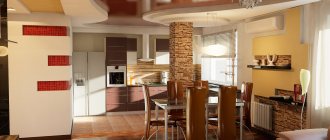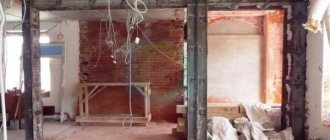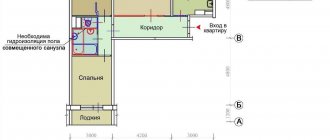The standard layout of a living space rarely allows the owners’ design ideas to be realized. Then homeowners think about refurbishment of the “squares”. But most design changes fall under redevelopment, which means they need permission from the housing inspectorate and other supervisory authorities.
However, you don't always need to worry about this. If you know which redevelopment of an apartment or house does not require approval, you can significantly reduce time and financial costs.
What kind of redevelopment does not require permission?
Structural changes to residential areas that require inclusion in technical and cadastral documentation are considered redevelopment. If, as a result of such changes, it is expected that the area of residential and non-residential areas will change, and the walls will change their original position, such activity should only take place with the permission of the housing inspectorate.
But if we take into account the definition of redevelopment in the Housing Code, then it is necessary to coordinate only changes that can affect the structural integrity of an apartment or house, changes in its area and blocking of ventilation outlets and communication lines. Those works that do not affect the above indicators are considered permitted and do not require any additional legalization.
What types of redevelopment do not need to be approved:
- design or sewing of openings in non-permanent partition elements;
- disassembly of mezzanines, closets;
- installation of door panels, including rotating and sliding ones, and display cases without changing their dimensions;
- arrangement of built-in furniture and household appliances without creating new closed areas;
- installation of a partition that can be easily disassembled and moved to a new location.
You do not always need permission to glaze a balcony or loggia, even though it is a redevelopment. If the load on the floor slab hardly increases, and the appearance does not deviate from the design concept of the building, then upgrading these elements can be done without any approval. Unless, of course, your house is one of the cultural and architectural monuments. In this case, you need to obtain the consent of specialists from the relevant department of the locality administration.
You can also install an additional hood and split system without removing the old ones, and install a mosquito net.
Actions that do not require approval and are not considered redevelopment also include cosmetic repairs of any complexity. This can be wall, ceiling and floor coverings. This category also includes the replacement of plumbing fixtures, as well as elements of the heating system. But, say, moving plumbing into a room, even without changing the pipeline outlets, is impossible without approval.
It is quite possible to legalize illegal redevelopment if it does not violate construction and sanitary standards. But, quite possibly, there is no need to do this if the changes are not those that require permission.
How to understand whether you can do redevelopment or not
If you cannot figure out whether the work you want to do is allowed or not and how to properly coordinate it, ask the specialists. During the consultation, the necessary questions will be asked and the success of the agreement will be assessed. It is faster and more reliable than searching for information in different sources. Let's tell you how this happens in our company.
At APM-1, consultation is free. You can make an appointment and come to an appointment, you can write to us on WhatsApp or by mail, or call the manager +7 (495) 181-13-09. We will definitely answer your questions. Then the engineer will come to your apartment, inspect it and check for any pitfalls. Extensive experience in working with the Moscow Housing Inspectorate allows us to make accurate forecasts and take into account what inspectors do or don’t let in in practice.
If we understand that some work cannot be completed, we will definitely tell you about it and offer options on how to solve your problem differently.
Leave a request for a free consultation on apartment redevelopment
Zamyatin Dmitry Alekseevich
Zamyatin Dmitry Alekseevich
General Director of LLC "APM-1" Design workshop PEREPLAN.
Education: Higher technical (Master's degree from Moscow State University of Civil Engineering)
Specialization Coordination of redevelopment of commercial and residential real estate in Moscow and St. Petersburg
Is permission required for the conversion of non-load-bearing walls?
If you start modifying non-permanent walls without moving them, in most cases the redevelopment may not be approved. This may involve dismantling old structures and erecting new ones in the same place in strict accordance with the technical passport.
There is no need to regulate partition structures built in a new location if they are small in size and can be easily dismantled.
These include:
- light arched partitions;
- bar counters;
- kitchen islands;
- ledges and niches;
- rack bulkheads;
- glass sliding doors;
- openwork screens and various screens.
If you intend to install a partition that does not carry a load on the floor slab, complies with sanitary standards, but at the same time transforms the living space, you will not need to obtain permission for redevelopment from the housing inspectorate.
It will be enough to make a change to the technical plan in the BTI according to the sketch and to the Rosreestr data. The most common example of such redevelopment is the division of adjacent rooms into separate ones. All these actions are provided for by the Housing Code. According to it, any changes that are made to the design of the housing or related to its area must certainly be reflected in the technical passport. Even if you don’t need to obtain planning permission.
The procedure is quite simple: a specialist from the Technical Inventory Bureau inspects the premises, compares it with the sketch and gives the go-ahead for repair work. After this, a check is carried out and a new technical document is drawn up. If such a redevelopment has already been done, it is easiest and fastest to legalize it.
It is important that not only the areas of residential and non-residential premises do not change, but also that the load on the flooring does not increase. If it is decided to erect a heavy monolithic wall, it will require approval, since violation of the technology can lead to the destruction of the building.
When modifying partitions, it is not permitted:
- construction and removal of load-bearing walls;
- construction of false walls that create blind areas without lighting and central heating;
- structures that change the architecture of the building.
It is also not allowed to embed a gas pipeline into a new wall or block ventilation outlets.
It will be necessary to submit an application for redevelopment to the housing inspectorate and create a project if it is planned to move partition structures under windows and doors, increase living space at the expense of non-residential premises, or arrange additional non-residential areas, for example, storage rooms.
Carrying out reconstruction
According to Art. Housing complex of the Russian Federation, reconstruction is considered to be the change, replacement or installation in the apartment of various engineering networks, electrical equipment, plumbing or other equipment, after which the necessary amendments are made to the cadastral passport. At the same time, during redevelopment, a larger overhaul of the premises is carried out. In this situation, they dismantle large and small interior partitions, increase the living space by adding a storage room, etc.
These changes are also recorded in the cadastral passport.
What can you do
According to clause 1.7.1 of the Resolution of the State Construction Committee of the Russian Federation No. 170 of September 27, 2003, when renovating an apartment without approval, the following repair work is carried out:
- installation of various electric stoves;
- transfer of water heaters, KGI;
- installation and reconstruction of outdated toilets and bathrooms;
- laying 1 or several new or replacing outdated pipelines, electrical networks and various devices when installing shower cabins, Jacuzzi bathtubs, automatic washing machines, etc.
When remodeling an apartment, the following legal actions are performed:
- connect the kitchen with the hall or other adjacent room. Then another doorway is installed in the wall;
- build an open interior arch - connect the kitchen with the hall or another room;
- increase the area of the bathroom or toilet due to part of the corridor. In this case, the floor in the bathroom is 3-5 cm lower than the hallway flooring;
- they stretch new plastic or other pipes and move the water tank of the sewer riser in the bathroom from one place to another. At the same time, the drainage angle is maintained;
- insulate the balcony with glass.
Important! When renovating housing without prior approval, consult with an engineer or highly qualified designer in advance. After the redevelopment is completed, a housing inspection specialist is invited, who draws up an acceptance committee report. Based on this document, in the future they will receive a new BTI plan and an extract from the Unified State Register of Real Estate.
What work cannot be carried out without permission
When renovating an apartment, the following actions are prohibited:
- demolition of load-bearing interior structures or disruption of the stability of apartment walls;
- an increase in kitchen space, a significant expansion of a bathroom or small bathroom at the expense of living rooms;
- combining a hall or other room with a kitchen where there is a gas stove;
- demolition or disruption of the operation of communal heating radiators and radiator pipes connected to them;
- arrangement of a toilet or bathroom in a place where the residents have a living room below;
- provision of underfloor heating through central heating systems;
- expansion of a small balcony at the expense of the hall or another nearby room (with the exception of the construction of arches up to 1 m wide);
- apartment redevelopment and refurbishment in a residential multi-storey building, which is recognized as unsafe;
- disruption of the functioning of various ventilation systems at home;
- construction of an attic;
- attic conversion.
Attention! Reconstruction in the kitchen is carried out only if there is at least 1 window opening there. When opened, the windows provide good illumination of the kitchen area, natural exhaust of various harmful odors and fumes, and also quickly ventilate gas leaks.
Non-residential premises
Detailed information on the organization of re-equipment and redevelopment of various non-residential premises is specified in the Decree of the Government of Moscow No. 508 of October 25, 2011. Such objects have a number of features that are given in the Law of the Russian Federation of July 21, 1997 No. 122-FZ.
When carrying out major repairs in these places, approval is also required for reconstruction and other similar work. According to the law, redevelopment is also carried out in a variety of non-residential premises. For example, this is done in offices that are located in office buildings. To obtain official permission to carry out such repair work, they go to the architecture department.
Important! During any major apartment renovation, the specific purpose of non-residential or specific residential premises is preserved.
For example, a new grocery store is not opened in a formal conference room.
Read also: How to write a complaint to Rospotrebnadzor
According to clause 9 of the Law of the Russian Federation of December 27, 2021 No. 558-FZ on the redevelopment of apartments and various non-residential premises in apartment buildings, in clause 3 of Ch. 4 of the RF Housing Code some amendments have been made. Now, if the refurbishment of a specific apartment is impossible without attaching part of the common property of a multi-storey residential building to this property, then in this situation a protocol of the general meeting of owners is drawn up, which reflects the consent of the majority of the residents of the building to carry out such repair work.
Federal Law of July 21, 1997 No. 122-FZ “On state registration of rights to real estate and transactions with it”
How to legitimize
Official permission to carry out unauthorized redevelopment in an apartment or private house is often obtained by going to court (Part 4 of Art. LC RF).
In this situation, perform the following actions:
- File a claim in the local district court;
- Collect the necessary documentation above;
- They pay a state fee of 300 rubles. and the receipt is added to the package of documents;
- They come to the court hearing;
- Conduct a separate examination (if necessary);
- Receive a court decision.
Attention! After receiving a positive court decision, a new cadastral passport is issued. If the claim is refused, an appeal must be filed within 1 month.
Is a permit required to demolish or move a non-load-bearing wall?
If the new wall does not affect the main floors, does not load them, and does not change the area of the apartment, its construction is not classified as redevelopment, but as repair or reconstruction work. No permitting documentation is required. And to legalize it, you don’t need to contact the housing inspectorate. It is enough to communicate with BTI specialists.
No approvals are required at all if your partition can be easily disassembled. Even when selling an apartment, if the structure is not needed by the new owner, it will simply be dismantled.
But before starting renovations, you need to independently find out all the nuances of the housing complex, sanitary and construction standards, or seek advice from the design bureau. It is possible that in your case you will need to make changes to the technical passport and coordinate them with the supervisory authorities.
Some types of wall transfers cannot be performed, even if they are not major. Not allowed:
- reduce the area of rooms by more than a quarter;
- move partitions so that rooms without windows and radiators are formed;
- cover the utility network with a permanent bulkhead or truncate the ventilation duct.
There is also a ban on reducing the size of the kitchen. This room is the most fire hazardous in the apartment. As the area decreases, the risk of fire increases.
As for the demolition of non-permanent partition structures, there are some nuances here. There are certain prohibitions on dismantling even non-load-bearing walls. These include the removal of partitions installed in different rooms:
- demolition of the wall between the room and the kitchen with a gas stove in a one-room apartment;
- combining the landing and corridor;
- elimination of thresholds located on balcony exits;
- expansion of the loggia at the expense of the room;
- dismantling window sill blocks;
- connection of two residential properties if their owners are different people.
The partition between the bathroom and the kitchen cannot be demolished. But it is not difficult to agree on the combination of a toilet and a bathroom into a single zone - such a transformation will only need to be certified by the BTI.
If a partition structure has already been erected in an apartment purchased on the secondary market and is not included in the technical passport, it must be made legal. Or dismantle without any approval - demolition of a structure not specified in the documentation is not included in the redevelopment of the apartment.
What not to do when remodeling an apartment
First of all, redevelopment cannot be done without approval. Redevelopment is those changes to the apartment that are reflected in its technical plan. Each apartment has this plan; it is stored in the BTI along with the registration certificate. And if you don’t yet have a technical certificate, you will still have to get it for redevelopment. This may be the case if the apartment is in a new building.
The technical plan shows the boundaries of all rooms, all doorways and window openings. All technical and plumbing equipment is also marked. If you are renovating and plan to cut a new opening in the wall or move walls, be sure to coordinate the work first. Otherwise, the redevelopment will be considered illegal.
The apartment plan shows whether a door is installed in the doorway or not. Therefore, if you want to remove the door and create a decorative opening, this is also a redevelopment. But you can simply replace doors without approval
Not all work can be agreed upon in principle. If they do not comply with building codes and sanitary rules - snips and sanitary regulations, permission cannot be obtained, and the completed redevelopment cannot be legalized. Let's talk about this in more detail.
Moscow Government Decree No. 508-PP - clause 10 of Appendix No. 1 lists all the work that is prohibited from being performed and cannot be agreed upon.
In the kitchen. The most stringent requirements for kitchens with gas stoves. Since gas is explosive, all work with gas equipment must be supervised by Mosgaz technicians. The kitchen must be isolated - making a studio if there is a gas stove will not work.
It is forbidden:
- combine a kitchen with a gas stove and a living room
- move a gas stove without permission from the gas workers
You can install glass doors between the kitchen with a gas stove and the living room. But they won’t be allowed to install accordion doors. The door should close tightly. Although no one forces you to keep it closed all the time
Redevelopment of a two-room apartment - options, photos and examples
In the bathroom. Bathroom is a common name for a bathroom and toilet. These are wet areas because water supply pipes run there. There is a risk that the pipes will leak, the faucet will break, or they will forget to turn off the water. To reduce the risk, waterproofing is placed on the floor, and requirements for the location of the bathroom are also established. It is impossible for neighbors’ living rooms or kitchen to be located underneath it.
It is forbidden:
- move the bathroom and toilet to the living part of the apartment
- expand the bathroom at the expense of the living room
Moving a bathroom into a living room or expanding it at the expense of it is possible only in one case - the apartment is on the ground floor. This means that there are no neighbors below and there is no risk of flooding them with water in the event of an accident
There are additional requirements that are important to comply with during repairs.
It is forbidden:
- trim ventilation ducts and make niches in them
- demolish thresholds in the toilet and bathroom
The threshold is located at the entrance to the bathroom, bathtub or toilet. It cannot be demolished and cannot be replaced with plastic. Height - 2 cm. Code of rules 29.13330.2011 “Floors”, clause 4.8
Loggia and balcony . In Moscow, it is impossible to combine a loggia and a living room if this is not initially provided for by the house design. Such work is not approved. When the partition is demolished, the heat will not be distributed correctly throughout the house. In addition, it is not always possible to install panoramic glazing on a balcony or loggia. If all balconies in the house have a railing at the bottom, this style must be followed.
It is forbidden:
- combine loggia and room
- glaze the balcony to the floor if the rest of the house has standard balconies, with a blocked bottom
Part of the wall between the loggia and the balcony can be demolished, but you still need to install a partition, for example, a double-glazed window from floor to ceiling
Load-bearing walls. The entire house is supported by load-bearing walls. Therefore, you need to work with them carefully. Large-scale interventions are prohibited. But small-scale projects like new doorways must be approved. Permission will not be given for all work - it depends on the type and series of the house. The conclusion on the possibility of redevelopment is prepared by the organization - the author of the house project.
It is forbidden:
- demolish load-bearing walls entirely
- cut openings in load-bearing walls without the consent of the author of the house project
- make new openings without reinforcement
An example of strengthening an opening in a load-bearing wall. It is called U-shaped. Strengthening one opening costs from 45,000 ₽
Heating. The heating system is used by all residents of the house. Therefore, this also has its own requirements and prohibitions - other residents should not suffer from your actions. An inspector from the Moscow Housing Inspectorate will check whether batteries are being used for other purposes, for example, as a source of hot water for heated floors.
It is forbidden:
- make heated floors using radiators
- transfer batteries to a balcony or loggia
- sew up heating risers and radiators without access to them
Drywall boxes may look more aesthetically pleasing, but they cannot be made. If the pipe becomes clogged or bursts, it will be very difficult to reach through the box.
Repair without errors: basic rules and common violations
Coordination of moving the doorway
When redeveloping residential premises, the question often arises about the need to coordinate the relocation of the doorway. After all, there is no transformation of the areas.
There is the same nuance here as when constructing a new bulkhead. If the structure where the location of the door is changed or an arch is made is easily dismantled, then there will be no problems with the openings either. Such actions do not require any permission or subsequent legalization, since they are not considered housing redevelopment.
But in other cases, moving a doorway in a non-permanent wall will require contacting the BTI. After all, despite the fact that there were no changes in area, the doors are marked in the technical plan. Therefore, the documentation will have to be updated. But it’s easier to do this; there’s no need to even change entries in Rosreestr.
Entering new data into the technical plan will be sufficient here, in contrast to transforming openings in the main walls. There, permission from the housing inspectorate is required, because such refurbishment can affect the structural characteristics of a residential building.
There are also prohibited aspects in the formation or sewing of openings. So, you can’t cut a second passage to the kitchen. In this case, a wind tunnel is created, which impairs ventilation. It is also prohibited to modify window openings in main walls.
What changes will have to be abandoned?
According to sanitary and building standards, transformation of residential premises is not permitted, which is capable of:
- worsen the general operating conditions of the building and the requirements for people living in it;
- impede access to main utilities, including water supply, sewerage and energy supply networks;
- violate the strength and change the stability indicators of main walls and ceilings (to avoid destruction of the building);
- reduce the diameter of the ventilation ducts or simply remove them.
If your idea falls under any of these points, it will never be allowed. If illegal redevelopment is detected, representatives of supervisory authorities demand a complete reversal of transformations not permitted by law and will issue a fine for illegal redevelopment. Such strict rules are due to the fact that changes in the house can pose a danger or cause discomfort to those living in it.
The same applies to increasing the load on load-bearing elements in excess of what is permissible according to the design documentation:
- when installing new screeds on the floor;
- when dismantling light partitions and replacing them with floors made of heavy materials;
- when placing additional equipment in the living space.
However, some overloads of capital floors are sometimes allowed.
This is possible in the case of additional structural reinforcements according to a carefully verified project, which will require significant costs and largely depends on the material from which the building is built, its service life and number of floors. So, for example, with approval, you can create a new doorway in a solid interior wall of a good-quality house. Banned changes that are never approved:
| Premises | Redevelopment that will be denied |
| The whole apartment | Construction of openings in areas connecting connecting structures with prefabricated elements. |
| Creation of grooves for electrical communications or water mains in horizontal joints under wall panels, in floor slabs. | |
| Installation of heated floors by removing coolant from a common heating pipe. | |
| Dismantling of load-bearing walls and ceilings. | |
| Dismantling of window sill blocks. | |
| Construction of partitions that block natural light and divide rooms into zones without heating. | |
| Rooms | Reducing the area by more than a quarter. |
| Kitchen | Combination with a room in a one-room gasified apartment. |
| Bathroom | Relocation of inputs and outputs of hot water supply lines, hot water supply lines, drainage pipes - the so-called “wet places”. This also applies to the kitchen. |
| Transferring plumbing fixtures to a living room or hallway. | |
| Balcony and loggia | Increasing the area of the architectural element due to the living room. |
| Expansion of existing structures at the entrance to the living space. | |
| Demolition of thresholds located on balcony exits. | |
| Installation of radiators and cooking appliances. | |
| Corridor | Connection with staircase. |
If your idea is not on the list, the likelihood that the redevelopment will be approved is high. If no fundamental changes are expected, then the decision of the BTI with the inclusion of new indicators in the technical plan and in Rosreestr will be sufficient. If the redevelopment is significant, then a project will be required. It can also be ordered from the BTI or contact a specialized bureau.
In case of illegal redevelopment, the type of which is prohibited, it is worth trying to return the home to its previous appearance. It will still not be possible to legalize it, but an administrative penalty in monetary terms will certainly be imposed.
How to find out which wall is load-bearing?
When planning the demolition of a particular wall, you need to make sure in advance that it is not load-bearing. Thus, there are several ways to recognize a capital structure. It could be:
- Involving professionals - you can invite a specialist from the organization that was originally involved in developing the plan for the apartment building, or from any other design company. In this case, the most accurate answer will be provided.
- Determine the load-bearing wall yourself - when choosing this option, you should definitely take into account the material from which a particular house is made. In this case, you should pay attention to the thickness of the wall.
For example, in panel houses the thickness of the main walls can be 14, 18 and 20 cm (interior partitions - 8 and 10 cm).
If we talk about a brick house, then in this case the load-bearing structure will be a structure more than 38 cm thick.
To summarize, it should be noted that the redevelopment of walls must be legalized if it is planned to demolish them, move them to another place, create openings, etc. It must be remembered that dismantling the main wall is strictly prohibited.
It is only allowed to create an opening in the supporting structure, however, this must also be approved by the Housing Inspectorate. Otherwise, the apartment owner will face a number of negative consequences.
How to arrange a reorganization
If your redevelopment is one that does not require approval, you do not need to formalize anything. You can safely purchase building materials and do repairs. In other cases, you will need to collect documents, without which the application for the possibility of redevelopment will not be accepted. It is compiled according to the state model, which can be found on the resources of the MFC, BTI and housing inspection.
It must be accompanied by:
- a document from Rosreestr confirming that you are the owner of the property;
- technical certificate of the premises;
- written approval of all registered on potentially redeveloped square meters.
If drastic changes are proposed, design documents will be required.
BTI or design and architectural bureaus will help with this. You only need to contact licensed organizations. Difficulties may arise if the building has cultural or historical heritage status. In this case, you will need permission for redevelopment from local administration specialists supervising these areas. Practice shows that they are not very willing to agree on changes.
The owner of a non-residential premises who wants to redevelop it cannot be just an individual. Changes in such buildings are allowed only to the founders of an LLC or individual entrepreneur.
When all the papers have been collected, you need to contact the MFC, housing inspectorate or administrative department that oversees housing issues in your city. After submitting the application, you will need to wait a month and a half for a decision, although usually everything is agreed upon faster - in two to three weeks.
After this, you will receive a permit document, which will indicate the time given for the redevelopment. After its expiration, the selection committee will come to visit you and evaluate the quality of the changes and their compliance with the project. If everything is done correctly, changes will be made to the technical and cadastral plan, as well as to the Rosreestr records for your redevelopment.
It is necessary to distinguish between redevelopment and reconstruction. The latter refers to changes in the field of engineering and technical communications. For them, permits must be obtained from Rospotrebnadzor, fire services, environmentalists, and the Ministry of Emergency Situations. But communication with BTI representatives is most often not required, since nothing usually changes in planning documents during reconstruction.
Not all redevelopments are approved immediately, even those that do not violate the requirements. There is a risk of being rejected. If there is a slight misunderstanding or problem, you can make corrections to the project and come back with a new application after 90 days. In this case, a review of the previous decision should be required. Another groundless refusal can be challenged in court.
If you need to legalize redevelopment that has already been done, you need to contact the Technical Inventory Bureau. Perhaps a sketch will be enough to correct the technical plan. Simple and compliant changes are legalized quickly and without problems. After this, you will receive new cadastral and technical documents, and information about your real estate will be changed in Rosreestr.
If the housing has been significantly changed, in order to legalize the redevelopment, you will have to go to court. To do this, you will need the same list of documentation as when filling out the application, as well as an assessment by specialists who will conduct a construction and technical examination. If fire, sanitary and hygienic and building standards are not violated, the likelihood of a decision in your favor is high.
What can you do without a project?
To legalize the redevelopment, you need to order the project from a company with SRO approval. Our company is a member of the SRO “MezhRegionProekt”, and for each redevelopment project we attach an extract from the register of members of our SRO. On our website you can see what redevelopment projects look like.
You can do without a project in several cases:
- your renovation is not a redevelopment
- simplified sketch approval suits you
- you have chosen a suitable standard project and there is no need to order an individual one - in practice, it suits few people
Repair is not redevelopment. If the work is not shown on the apartment plan, it is not a redevelopment. There is no need to order a project and coordinate them. This applies to all finishing work, replacement of electrical wiring, bathroom pipes, plumbing fixtures, doors and plastic windows.
In addition, you can demolish and equip built-in wardrobes without approval, as well as glaze the balcony. In practice, these works do not require any approvals. The only thing is that we advise all owners of balconies on the upper floors to glaze their balconies only after agreement with the Moscow Housing Inspectorate. This will protect against possible claims in the future if such glazing is banned. And such conversations go on, especially in winter, when ice begins to fall from the canopies above the balconies.
Moscow Government Decree No. 508-PP - clause 2 of Appendix No. 1 lists the work that requires the preparation of a redevelopment project.
Can be coordinated according to the sketch. If the redevelopment is simple, a sketch is enough to coordinate it - this is one sheet of paper that reflects the apartment plan and the planned changes. You can draw it yourself or order it from designers. For example, we have it for 5,000 ₽.
This is what the redevelopment sketch looks like, which is done in APM-1
Based on the sketch, you can agree on a redevelopment in which:
- Wet areas are not tolerated - bathroom, toilet and kitchen
- load-bearing and load-bearing walls are not affected
- When renovating a kitchen, the type of stove does not change - from gas to electric; the gas stove is not transferred
- When replacing the floor covering, the internal structure of the floor does not change
For example, according to the sketch, you can divide a large studio into several rooms. But if the house is old, with wooden floors, you will have to order a project and contact the author of the house project.
What redevelopments do not require approval in 2021
What are the dangers of unauthorized reconstruction?
If redevelopment of an apartment does not require permission, the owner of the squares will not face anything. He can safely sell, exchange, donate real estate, and invite representatives of supervisory authorities to visit. A small illegitimate redevelopment.
The consequences of large-scale illegal redevelopment of an apartment without approval are disastrous. Of course, until the fact of transformation of the area is revealed, the owner of the premises lives quietly, sometimes for decades. But if he wants to sell or donate the apartment, or neighbors complain about the consequences of the redevelopment, he will have to try to legitimize it.
Some citizens transform their homes as they please, so legalization is not always successful. Such a person will have to pay a fine of 2,500 rubles and restore the property in accordance with the technical plan.
If the owner of the “squares” refuses, and the court does not side with him, his apartment can be sold at auction, and part of the proceeds from the sale will be used to return the design characteristics. In this case, the wishes of the former owner will not be taken into account.
Even if it seems to you that the planned refurbishment of housing should not require either approval or permission, it is still better to get advice from the BTI. There may be a need to make changes to the technical and cadastral passport, or even the creation of a project will be required. It is better to approve all changes in advance than to pay fines and go to court later.
Frequently asked questions about what is and is not possible when remodeling an apartment
Will they approve the redevelopment based on my sketch?
Yes, if it is done correctly, and the repair does not involve moving or dismantling walls, does not change the boundaries of the bathroom, kitchen and toilet, does not create or lay openings in ceilings and load-bearing walls, does not install stairs and podiums, does not move or create kitchens niche kitchens.
The sketch is made on the BTI plan of the apartment. Typically, partitions being dismantled are marked in red, and partitions being erected are marked in green. An explanation for the new layout is also drawn up and the activities planned during the renovation are outlined. You can prepare a sketch yourself, but it’s better to contact a design office. Our service costs 5,000 rubles.
What documents need to be collected to redevelop an apartment?
To approve the redevelopment at the Moscow Housing Inspectorate, you must prepare title documents for the residential premises, a redevelopment project with a technical report on the safety of the work being carried out (this is done by a company that is a member of the SRO), and a technical passport for the apartment. If the apartment is under a mortgage, then you also need to attach the bank’s consent to renovate your home. An application will be attached to this list, which will be given to you at the MFC when you fill out an application to the Moscow Housing Inspectorate.
Is it possible to legalize redevelopment if it has already been done?
Yes, you can. To do this, first of all you need to contact the BTI for the original apartment plan. Then - to an organization that is a member of the SRO to make a redevelopment project. For example, in APM-1, where they will check the structural components of the apartment and house and issue a technical opinion on the work performed. Next, the package of documents is sent to the Moscow Housing Inspectorate for approval and coordination of the planned work. The final stage is obtaining a new registration certificate for the apartment from the BTI and making changes to Rosreestr.
The main thing in coordinating the already completed redevelopment in the apartment is that all work complies with the law, construction and sanitary requirements.










